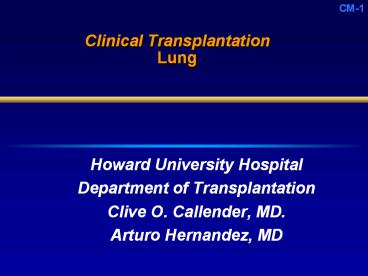Clinical Transplantation Lung - PowerPoint PPT Presentation
Title:
Clinical Transplantation Lung
Description:
Clinical Transplantation Lung Howard University Hospital Department of Transplantation Clive O. Callender, MD. Arturo Hernandez, MD – PowerPoint PPT presentation
Number of Views:116
Avg rating:3.0/5.0
Title: Clinical Transplantation Lung
1
Clinical Transplantation Lung
- Howard University Hospital
- Department of Transplantation
- Clive O. Callender, MD.
- Arturo Hernandez, MD
2
Objective
- Current Status of Lung Transplantation
3
No of Transplanted Organs vs Waiting List 2004
- Recovered Transplanted
Waiting List - Total 25,237 26,539 86,378
- Kidney 12,575 15,671 (9,025) 57,910
- PTA 2,021 132 504
- PAK 418 973
- K-P 879 2,410
- Liver 6,405 5,780 (5,457) 17,133
- Intestine 167 52 196
- Heart 2,096 1,961 3,237
- Lung 1,973 1,168 3,852
- Heart-lung 37 171
-
Source
2005 OPTN/SRTR Annual Report,
4
Graft Survival
- Follow-up Period 1 Year 10 Years
- Tx 2002-2003 Tx 1993-2003
- Kidney Deceased Donor
- Graft Survival 89.0 40.5
- Patient Survival 94.6 60.7
- Kidney Living Donor
- Graft Survival 95.1 56.4
- Patient Survival 97.9 76.4
- Kidney-Pancreas
- Kidney Graft Survival 91.7 52.5
- Pancreas Graft Survival 85.8 53.6
- Liver Deceased Donor
- Graft Survival 82.2 52.5
- Patient Survival 81.7 67.0
- Intestine Graft Survival 73.8 22.0
- Heart Graft Survival 86.8 51.1
- Lung Graft Survival 81.4 22.1
- Heart-Lung Graft Survival 55.8 24.6
UNOS/SRTR, 2003
5
Current Status of Lung Transplantation
- Long term survival50 die by 5 years
- Bronchiolitis obliterans (chronic
rejection)primary cause of poor survival - Future of lung transplantation is prevent
bronchiolitis obliterans
6
Lung TransplantationPre-Cyclosporine Era,
Pre-1983
100
At risk
(38)
80
(28)
60
free from death
(19)
40
(12)
20
(4)
0
0
50
100
150
200
250
Time (days)
7
Worldwide Lung Transplantation Numbers
Lung transplants performed worldwide, by year
Primary diagnosis, 01/1995 - 06/2003
1706
1655
1.8 2.6 4.2
1537
1508
1410
10.4
1413
1417
1337
1342
39.0
9.0
1206
1069
16.0
17.0
902
685
Emphysema/COPD Idiopathic pulmonary
fibrosis Cystic fibrosis Alpha-1 antitrypsin
deficiency Primary pulmonary hypertension Sarcoido
sis Retransplant/graft failure Other
408
185
80
47
15
13
Source International Society of Heart and Lung
Transplantation (ISHLT) UNOS
8
Comparative Transplantation Survival Rates
Chiron Briefing Document Figure 2.2-1
Primary lung transplant by underlying diagnosis
Primary kidney, liver, and heart transplant
Kidney, liver, and heart data extrapolated from
OPTN Annual Report, 2003.
9
(No Transcript)
10
Clinical Manifestations of Chronic Rejection
- Two methods for the diagnosis of chronic
rejection - Histologically through transbronchial biopsy (OB)
- Clinically through sustained decline in pulmonary
function (Bronchiolitis Obliterans Syndrome, BOS) - OB and BOS are histologic and clinical
manifestations of the same process - Patients develop progressive shortness of breath,
graft failure, airflow obstruction, recurrent
pulmonary infections - Once chronic rejection develops, airway damage is
progressive and irreversible - Patients die of graft failure/pneumonia
11
Causes of Death Following Lung Transplantation
12
Despite Best Current Systemic Treatment and
Patient Management, Chronic Rejection Eventually
Affects Most Patients
chronic rejection-free survival
ofpatients
100
100
80
80
Tac
60
MMF
60
40
40
Despite best available therapy
CsA
AZA
20
20
0
0
0
1
2
3
4
5
6
7
Calcineurin inhibitors
Anti-metabolites
Prednisone
Years from transplant
Plus induction, plus pulsed intensifications prn
Source ISHLT, market research
13
New Concept Avoid Increasing Systemic
Immunosuppression
Non alloimmune factors
- Infection
- GERD
- Others
Immune activation
Increase systemic immune suppression
BOS
14
Pathway to Chronic Rejection
Non-alloimmune stimuli Airway ischemia Viruses
Bacterial - PSEUDOMONAS Oxidant stress Reflux
Alloimmune stimuli Recurrent acute vascular
rejection Lymphocytic bronchitis
Epithelial injury Inflammation Fibroblastic repair
15
Lymphocytic Bronchitis/Bronchiolitis
16
Acute Rejection
Acute rejection is a perivascular process
diagnosed by transbronchial biopsy
17
Separate Interventions for Separate Processes
rejection and ongoing injury, inflammation and
fibrosis ending in bronchiolitis obliterans
Systemic immunosuppression
Systemic administration to avert vascular
rejection, halting lymphocytic recruitment and
activation

